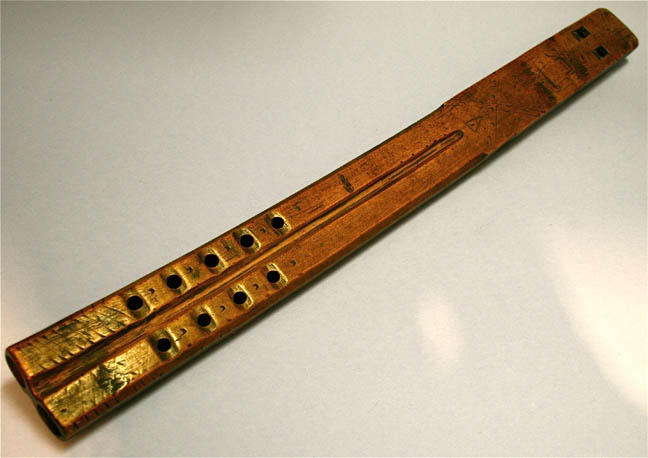

Title: 19th-C Antique Musical Instrument Dvojnica Wooden Shepherd Flute
Shipping: $29.00
Artist: N/A
Period: Unassigned
History: N/A
Origin: N/A
Condition: Museum Quality
Item Date: 1700 to 1800
Item ID: 1179
Dvojnica - Antique Double flute, is a two-sided hand-carved one-of-a-kind, ancient wooden rare instrument. / 18th 19th-century antique wooden flute. A musical instrument Large wooden flute made by shepherds in the open fields. This flute is hand-crafted and its unique design was derived from the ideas and imaginations of the woodcarver, creator, and user of this old musical instrument. We are committed to enhancing our customers’ lives by discovering creating and pointing out only the best art we can find in the world today. We Are Taste-Makers, Art Advisers & Consultants. The shepherd's flute is a type of wind instrument that has a long history, dating back to ancient civilizations. It is a type of simple flute that is typically made of wood or bamboo and has a distinct, high-pitched sound. It is called a shepherd's flute because it was traditionally used by shepherds in pastoral settings, who would play the instrument to pass the time and entertain themselves while tending to their flocks. The shepherd's flute has a long, slender body with several finger holes along its length. It is played by blowing into one end of the instrument, while covering and uncovering the finger holes to produce different notes. The shepherd's flute is typically played in a vertical position, with the player using one hand to cover and uncover the finger holes and the other hand to support the instrument. Throughout history, the shepherd's flute has been used in many different cultures and has been a popular instrument in folk music, traditional music, and popular music. It is still played today in many parts of the world, and is enjoyed by people of all ages for its simple, yet expressive sound.
The Bulgarian dvoyanka is a double flute made of a single piece of wood, with six sound holes on one side. It is most frequently made of ash-wood, plum tree, pear tree, cornel or boxwood. The tune is played on the right pipe, while the left pipe provides a flat tone (or drone) as accompaniment. The playing structure on the right pipe is similar to that of the music played on the kaval. Line-dances and lively melodies are frequently played on it.
Link: http://en.wikipedia.org/wiki/Flute
The flute is a musical instrument of the woodwind family. Unlike other woodwind instruments, a flute is a reedless wind instrument that produces its sound from the flow of air against an edge.
A musician who plays the flute can be referred to as a flute player, a flautist, a flutist, or a fluter.
The flute has been dated to prehistoric times. It has appeared in different forms and locations around the world. A three-holed flute made from a mammoth tusk (from the Gei�enkl�sterle cave in the German Swabian Alb and dated to 30,000 to 37,000 years ago was discovered in 2004, and two flutes made from swans' bones excavated a decade earlier (from the same cave in Germany, dated to circa 36,000 years ago) are among the oldest known musical instruments. A fragment of the femur of a juvenile cave bear, with two to four holes, found at Divje Babe in Slovenia and dated to about 43,100 years ago, may also be an early flute. The Bible, in Genesis 4:21, cites Jubal as being the "father of all those who play the ugab and the kinnor". The former Hebrew term refers to some wind instrument, or wind instruments in general, the latter to a stringed instrument, or stringed instruments in general. As such, Jubal is traditionally regarded as the inventor of the flute (a word used in some translations of this biblical passage). Some early flutes were made out of tibias (shin bones). Playable 9000-year-old Gudi (literally, "bone flute"), made from the wing bones of red-crowned cranes, with five to eight holes each, were excavated from a tomb in Jiahu in the Central Chinese province of Henan.